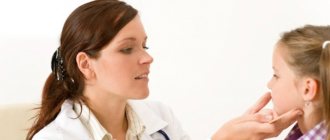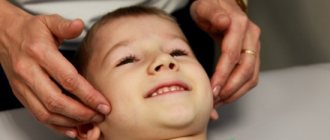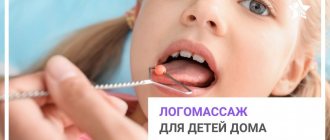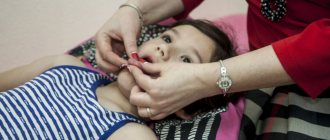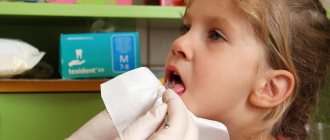Speech therapy massage is one of the methods used to correct speech. It is prescribed for complex pathologies when impaired muscle tone affects pronunciation. There are several proprietary methods used by speech therapists in their work. For some, you need to take special training courses, while other methods can be used by parents or the child himself at home. One of these author’s developments is speech therapy massage with spoons by O. I. Krupenchuk.
Its goal is to normalize muscle tone by stimulating certain points associated with the speech centers of the cerebral cortex. In this embodiment, they use spoons rather than probes with spatulas. During the massage, the speech therapist pronounces his actions, and the child repeats after him. Vernacularization of actions contributes to the development of speech. By working with this technique, you can not only normalize muscle tone, but also develop the pronunciation, lexical and grammatical aspects of speech.
Advantages of the technique O. I. Krupenchuk
Spoon massage is becoming increasingly popular not only in home exercises, it is also used in kindergartens. This method is effective and has a number of certain advantages over other options for speech therapy massage:
- The child does not have a negative reaction to cutlery. Many children do not like it when a speech therapist uses probes and spatulas in his work.
- To carry it out, you do not need to take special courses, so parents and children can do this massage at home.
- You can use different temperatures during classes, which makes it possible to carry out a relaxing or stimulating effect.
- This technique can be used in group and individual lessons.
Of course, for serious speech disorders, this technique will not be as effective as a probe. But if the child has a persistent negative reaction to probes and spatulas and if speech defects are not too complex (for example, erased dysarthria), it should be included in correctional classes.
Article:
In recent decades, the number of children with speech disorders has been steadily increasing, and, as a rule, the most severe ones.
In addition to children with a disorder of one or two sounds, you can increasingly meet children who have 10-12 sounds missing or distorted, or even more. Often added to this are confusions of sounds, their replacement and violations of the syllabic structure, that is, the child cannot reproduce words without errors, rearranges syllables, simplifies consonant sequences, etc. Disturbances in the acquisition of the grammatical structure of the native language are also common. Correct, good speech is communication, self-expression, an instrument of cognition, and the prevention of most school problems.
Speech is a conditioned reflex. For its development, a physiological basis is necessary - the presence of unconditioned reflexes, normal hearing, healthy articulation and the nervous system. The work of a speech therapist without preparing this basis is often ineffective.
Massage in speech therapy correction is part of complex work. This method is especially effective for severe speech disorders - alalia, dysarthria, etc.
One of the most effective ways to correct speech disorders is speech therapy massage and self-massage.
Not only effective, but also ancient - massage has been known for more than one millennium, among all peoples of the world. Since ancient times, massage has been part of the art of medicine.
“massage” is not entirely clear . So, some authors believe that it came from the Arabic “mass” or “rnasch” - “gently press, touch” , others - from the Greek “masso” - “squeeze with hands” , others - from the Latin “massa” - “sticking to fingers .
Only at the end of the 19th century did science become seriously interested in massage. Since then, many methods of therapeutic, sports, cosmetic and health massage have been developed.
According to Professor B. R. Yaremenko, massage accelerates the reverse development of speech disorders by 4-5 times! You can do it both in classes with a speech therapist and at home with your mother. Massage is not addictive, but there are always benefits.
Self-massage is a massage performed by the child himself using hands or aids.
The use of self-massage with spoons in complex correctional work to overcome speech disorders significantly increases its effectiveness. Self-massage in speech therapy correction can be used to prevent dysarthric disorders in early preschool age, and it is also a dynamic articulation exercise that causes an effect similar to massage. Basic massage techniques: stroking, rubbing, kneading, vibration.
One of the new methods of speech therapy massage is massage with spoons, proposed and described by the famous St. Petersburg speech therapist, author of many manuals on speech therapy and preschool education - Olga Igorevna Krupenchuk, which has a number of advantages. Firstly, it helps to avoid a negative reaction to probe massage; the massage movements are quite simple, which allows you to teach children self-massage. Spoons do not require sterilization - just wash them. Secondly, different temperatures of the spoons can be used for a relaxing or stimulating massage. The area of influence of a spoon, even a coffee spoon, is much larger than the area of influence of a finger. You can use a spoon to make movements that are impossible to do with your finger. For example, pressing with the side edge, rubbing movements with the edge of a spoon, deep kneading of a large area; movements pushing back the lips, kneading the lips and cheeks with support on the entire scoop.
Thirdly, it can be easily mastered by interested parents and used at home.
In addition to all this, the use of spoon self-massage in speech therapy also helps develop fine motor skills in the child and helps in the practical mastery of prepositions and prepositional words.
A child, doing self-massage with spoons, easily learns the names of parts of the face.
Massage with spoons can be carried out both in a subgroup lesson and in an individual one, including it as necessary in the structure of the lesson.
When doing self-massage, the child performs movements with a pleasant effort and will never hurt himself.
You can take different spoons, which helps keep children interested in the activity. For preschool children, it is better to use coffee spoons. Spoons should be made of stainless steel with a minimum of decoration on the handle and a round rather than sharp tip.
If your child has a strong gag reflex, simply temporarily prevent him from moving the spoon in his mouth. And gradually deal with this problem individually: massage your tongue, starting from the tip, gradually moving the reflex boundary deeper. Talking with the child during the massage helps a lot, distracting his attention from the procedure. The fact is that the reason for this phenomenon is often psychological: an entrenched reaction to some influence in the past.
If the muscles are hypotonic and the child needs a stimulating massage, place a glass of cold water in front of him and let him dip spoons into it from time to time. For muscle hypertonicity, place a glass of warm water in front of him and let the child dip his spoons into it.
For massage you need to take 2 spoons for each child.
While working with your child, you can massage him with spoons, and then teach him self-massage so that he can do this at home under parental supervision.
Children learn self-massage techniques with spoons under the guidance of a teacher and speech therapist. When teaching children self-massage with spoons, the speech therapist demonstrates each technique on himself and comments on it. Children perform the massage technique independently: first with visual control (mirror), and then without it. Before performing self-massage techniques, children should take a calm, relaxed position. As children become familiar with hand and finger movements, they will become more coordinated and accurate. When self-massage techniques are mastered by children, it is possible to perform movements accompanied by a poetic text. The exercise is performed while reading a poem, and this is also no coincidence. Poems, as rhythmically organized speech, contribute to the formation of a sense of rhythm in children and are a nonspecific way to correct violations of syllabic structure.
The form of the training can be either individual or subgroup (4-5 people). Self-massage can be included in a speech therapy session, and self-massage techniques can precede or complete articulatory gymnastics.
Thus, massage with spoons has an effective effect in the prevention and correction of speech disorders.
Using self-massage with spoons in our work with children of middle and senior preschool age, we have identified positive results. Self-massage helps to normalize the muscle tone of facial and articulatory muscles, and the formation of the correct structure of the organs of the articulatory apparatus. Significantly reduces salivation, hyperkinesis, synkenesis and tongue deviation. The development of fine motor skills, precise, coordinated movements of the hands and fingers, which helps not only in speech therapy work, but also improves children’s self-care skills, and contributes to the best learning for children in the classroom. Self-massage with spoons using poetic forms helps improve memory by correlating movements with the text of poems.
Self-massage with spoons has a huge impact on the delivery and automation of sounds, as well as the assimilation and use of sound in children’s independent speech.
General tasks of speech therapy massage
Any of its variations are aimed at solving the following problems:
- stimulation of speech centers of the cerebral cortex;
- reduction or cessation of seizures, synkinesis;
- normalization of muscle tone;
- improving the functioning of articulation organs;
- improving the functioning of facial muscles.
Often during a session, the specialist voices his actions, focusing the child’s attention on sensations and the position of the organs of articulation. Therefore, speech therapy massage is an effective means of speech correction.
When performing a massage, you must follow a number of rules:
- The room should be warm to avoid excessive heat transfer after the massage, i.e. the temperature in the room should not be lower than 22-24 degrees.
- The massage is performed in a lying position on a table. The table on which the massage is performed should be covered with a blanket and a clean diaper. The room should have good lighting, but direct rays of light should not fall into the child's eyes.
- When performing a massage, hand movements should be soft, gentle, without jolts. Rings and any other jewelry should not be worn on hands.
- After the massage, the child should be dressed in warm, dry underwear to keep warm
- Massage is carried out after feeding, but not earlier than 1-1.5 hours, or before feeding. You should not massage your child before bedtime, as this excites him. After the massage, the child should rest.
- Massage movements are carried out along the course of the vessels - from the periphery to the center.
- When performing an abdominal massage, you should spare the liver area; you should not massage the genitals.
- When performing a back massage, patting and tapping the kidney area are excluded.
- Classes begin from the 10-15th day of life.
- Classes are held 3-4 times a day for 5-7 minutes.
The goals of O.I.’s methodology Krupenchuk
Of course, massage with spoons is aimed at solving common problems. But it also has specific goals that need to be taken into account during classes:
- securing various positions of the spoon in the hand;
- development of fine motor skills;
- improving coordination of movements and the ability to navigate in space;
- correction of speech development.
All manipulations are performed while short poems are recited. This contributes to the development of the tempo-rhythmic side of speech, which affects the syllabic structure of the word.
A set of exercises for children from 10-15 days of life to 3 months of age:
- Stroking hands (4-6 times)
- Stroking legs (4-6 times)
- Laying on the stomach
- Back massage (4-6 times)
- Abdominal massage (6-8 times)
- Reflex crawling
- Massage and reflex exercises for the feet. (3-4 times).
As the child grows, new elements are added to the daily set of exercises, and the time of the procedure increases. Your pediatrician and nurse masseuse will tell you more about massage and gymnastics techniques.
Improper, uncertain execution of techniques can cause discomfort in the child and cause harm instead of benefit. Therefore, before you start giving massage and gymnastics to your baby yourself, consult a specialist.
Features of conducting classes using the methodology of O. I. Krupenchuk
Be sure to wash your hands and cutlery before the specialist begins the session. At the beginning of the lesson, an adult introduces the children to the parts of a spoon. The child is first given one cutlery and asked to take it with the hand with which he usually holds it. The speech therapist recites the poem and shows the movements, and the kids repeat after him.
At first, they do not make any movements with their face, but simply carefully examine the cutlery:
- It is held vertically in front of the face and turned with a hole away from you and towards you.
- Holding a spoon in one hand, with the other hand they show and name all its parts.
Having mastered these actions, the children take the second spoon. All manipulations are now done synchronously. Then proceed to self-massage:
- Heaps of spoons stroking the lines of the forehead.
- Perform the same manipulations in the cheek area in a circle.
- Similar actions are performed in the temporal areas. Only apply gentle pressure at the end of each movement.
- The side side makes a movement in the direction from bottom to top along the cheeks.
- Stroking movements of the upper lip with the tips of spoons.
- Gent but frequent pressure over the entire surface of the lips with the same part of the spoon.
- Use heaps of spoons to knead the cheeks in a circle.
- The same manipulations, only in the direction from the corners of the mouth to the temples.
- Patting movements with heaps of spoons on the cheeks.
Each specialist can add his own movements, depending on the child’s characteristics. Due to the fact that it is possible to control the temperature of cutlery, it is possible to normalize the state of muscle tone. If they are warm, you will get a relaxing massage, which is necessary for increased tone. Cold spoons can have a stimulating effect, which is effective for hypotension.
Massage for certain diseases:
- Rickets (but not during the peak period!!!) - massage improves metabolic processes, prevents the progression of the disease, deformation of the musculoskeletal system, increases blood supply to the massaged area, stimulates redox processes in the muscles. Massage normalizes sleep. The massage is carried out carefully. I use stroking and rubbing. The duration of the procedure is 5-7 minutes.
- Changes in muscle tone - with muscle hypertonicity, hypotonicity or muscle dystonia. Massage techniques in this case are varied; stroking, rubbing, tapping and patting are used.
- Umbilical hernia - the purpose of massage is to strengthen the tone of the muscles of the umbilical ring, prevent the divergence of the rectus abdominis, and as a result reduce the risk of strangulation of the hernia.
- Colic in infants - the purpose of the massage is to stimulate intestinal motility and the passage of gases. The abdomen is massaged with stroking movements in a clockwise direction, after which the baby is laid on the stomach and the back is massaged with stroking movements.
- Flat feet, congenital hip dislocation, muscular torticollis, congenital clubfoot. Massage for these diseases should be performed in a clinic or at home by an experienced masseuse.
Contraindications for carrying out
Speech therapy tongue massage helps to cope with the following tasks:
- Correcting correct sound pronunciation.
- Normalization and formation of breathing (diaphragmatic, not upper or clavicular).
- Improving the condition and quality of the voice and vocal cords.
- Strengthening pharyngeal reflexes.
- Normalization of the correct trajectory of movement of the organs of articulation.
Parents should be aware that there are a number of contraindications. They are temporary and require you to postpone the activity for a while. For example, pediatric speech therapy massage is not recommended under the following circumstances:
- elevated temperature;
- colds or acute respiratory disease;
- inflammation of the gums;
- stomatitis;
- conjunctivitis;
- lymphatic drainage disorders;
- enlarged lymph nodes;
- if there is blood in the stool;
- herpetic infection.
There are other contraindications, but they are all removable. As a rule, massage is simply postponed until they are eliminated.
Speech therapy “Snail”
The speech therapy cochlea helps children automate sounds and develop phonetic hearing. The baby moves his hand along the pictures in the snail, naming the objects he sees.
Speech therapy snail with the letter “sh”
Along with the sound snail, various didactic games are conducted in speech therapy:
- “We name colors with a snail”
- "Arguing with a snail"
- “The tongue and the snail are doing exercises.”
Sound pronunciation
In speech therapy, sound pronunciation is the process of forming speech sounds. It is carried out by different parts of the speech apparatus:
- Generator,
- Resonator,
- Energy.
Sound automation games
In games with speech therapy snails to automate sounds, the child learns new words. At the same time improves pronunciation.
There are other games for automation:
- Walking games. While walking, a verse with a complex sound is recited.
- Repeaters. The kid tells what and who is doing, repeating after the adult.
- Halves. The child is asked to add half to the object: “There was half a dress, but now it’s a whole dress.”
